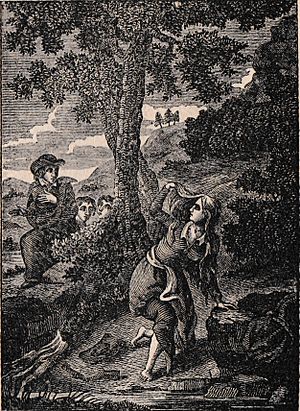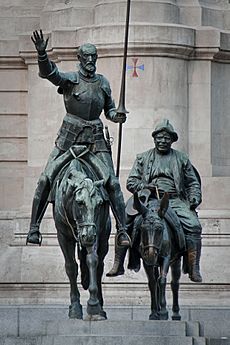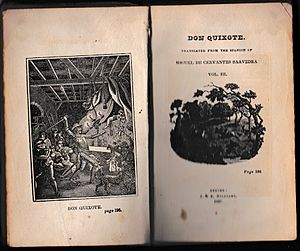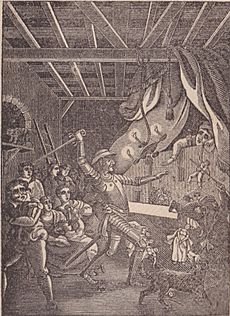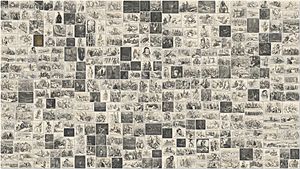Don Quixote facts for kids

Don Quixote de la Mancha (first edition, 1605)
|
|
| Author | Miguel de Cervantes |
|---|---|
| Original title | El ingenioso hidalgo don Quixote de la Mancha |
| Country | Habsburg Spain |
| Language | Early Modern Spanish |
| Genre | Novel |
| Publisher | Francisco de Robles |
|
Publication date
|
1605 (Part One) 1615 (Part Two) |
|
Published in English
|
1612 (Part One) 1620 (Part Two) |
| Media type | |
| 863 | |
| LC Class | PQ6323 |
Don Quixote is a famous novel written by Miguel de Cervantes. It was published in two parts, first in 1605 and then in 1615. Many people think it's the very first modern novel ever written! It was first written in Spanish. Soon after, it was translated into English by Thomas Shelton.
The main character is a man named Don Quixote. He tries to act like a brave knight from old stories. But he does it in a very silly and impractical way. Don Quixote is such a famous character that the word "quixotic" is now used to describe someone who is very idealistic but not very practical.
The story is about Alonso Quixano, a rich man who is not young or old. He reads many books about knights and their adventures. He reads so many that he starts to believe he is a knight himself! He changes his name to Don Quixote. He then rides around the country with his helper, Sancho Panza. They have many adventures. Don Quixote truly believes his adventures are real. But everyone else just laughs at him.
One of the most famous parts of the book is when Don Quixote fights windmills. He sees some windmills and thinks they are giant monsters. He rides his horse to fight them. But the windmills knock him off his horse. Sancho tells him they are just windmills. But Don Quixote does not believe him. He is sure a magician turned the giants into windmills to trick him.
At the end of the book, Alonso Quixano comes home. He is very hurt. He finally becomes sane again. Then, he dies.
For Cervantes and the people who read his book back then, Don Quixote was one book. It was published in 1605. It had four parts inside it. People didn't think it would have a second part.
Don Quixote, Part Two was a follow-up book. It came out ten years after the first one.
Contents
Behind the Story: How Don Quixote Was Made
Inspiration for the Book
Cervantes got ideas for Don Quixote from many places. One big influence was an old Spanish novel called Amadis de Gaula. This book was very popular in the 1500s.
Another important book was Tirant lo Blanch. Cervantes seemed to like this one even more. In Don Quixote, a priest calls it "the best book in the world."
Cervantes also used ideas from an Italian poem called Orlando furioso. For example, Don Quixote wants to find a magical helmet. This idea comes from a part of Orlando furioso.
An ancient Roman novel, The Golden Ass, also gave Cervantes ideas. Many of Sancho's adventures and the sayings in the book come from old Spanish and Italian folk tales.
Cervantes himself was once a galley slave in Algiers. This tough experience also helped shape his story.
Cervantes' family had many doctors and nurses. His father and great-grandfather were surgeons. His sister was a nurse. Cervantes also knew many people in medicine. He visited patients in hospitals. He had many medical books in his own library. These connections might have influenced his writing.
The Fake Second Part
We don't know exactly when Cervantes started writing Part Two. But he was probably working on it by 1614. Around September of that year, a fake Part Two was published! It was written by someone using the name Alonso Fernández de Avellaneda. This person was a fan of another writer, Lope de Vega, who was Cervantes' rival.
Some experts think Cervantes found out about this fake book earlier than Chapter 59 of his own Part Two. In that chapter, Don Quixote actually meets Avellaneda's book.
No one knows for sure who Avellaneda was. It's still a mystery!
Cervantes finished his real Part Two because of Avellaneda's fake one. Many experts now think Cervantes' second part is even better than the first. It has deeper characters and more interesting talks between Don Quixote and Sancho. In Cervantes' real Part Two, Don Quixote visits a printing shop. There, he sees Avellaneda's fake Second Part being printed. This is a cool example of a story talking about itself! Don Quixote and Sancho also meet a character from Avellaneda's book. They make him promise that the "other" Don Quixote and Sancho are not real.
Where the Story Happens
Setting the Scene
Cervantes' story takes place in the flat lands of La Mancha, Spain. Specifically, it's in an area called Campo de Montiel.
Cervantes starts his book with a famous line:
En un lugar de La Mancha, de cuyo nombre no quiero acordarme, no ha mucho tiempo que vivía un hidalgo de los de lanza en astillero, adarga antigua, rocín flaco y galgo corredor.
(Somewhere in La Mancha, in a place whose name I do not care to remember, a gentleman lived not long ago, one of those who has a lance and ancient shield on a shelf and keeps a skinny nag and a greyhound for racing.)—Miguel de Cervantes, Don Quixote, Volume I, Chapter I (translated by Edith Grossman)
Cervantes purposely didn't name the village. He explains why at the end of the book:
Such was the end of the Ingenious Gentleman of La Mancha, whose village Cide Hamete would not indicate precisely, in order to leave all the towns and villages of La Mancha to contend among themselves for the right to adopt him and claim him as a son, as the seven cities of Greece contended for Homer.
—Miguel de Cervantes, Don Quixote, Volume II, Chapter 74
In 2004, a group of university experts thought they found the village. They believed it was Villanueva de los Infantes.
Many people who have translated Don Quixote say that La Mancha is a very plain and dry part of Spain. It's not a place you would expect a brave knight to come from!
However, some people, like writer Jorge Luis Borges, have pointed out that the landscapes Cervantes describes in the book are not like real Castile. They are more like pretty, imaginary places with meadows and streams.
The story also takes Don Quixote to El Toboso. This is where he goes to get blessings from Dulcinea, the lady he loves in his knightly dreams.
Spain in Cervantes' Time
Don Quixote shows us what Spanish society was like when Cervantes lived. Spain was a powerful country, but it was starting to lose its strength. The country's money was running out because of expensive wars. The Protestant Reformation also made the Spanish Catholic Church feel threatened. This led to the Spanish Inquisition, which was a time of strict religious control.
Also, the hidalgo class (a type of lower nobility) was becoming less important. The old ideas of chivalry (knightly rules) were no longer useful in society.
The Book's Big Impact

How it Changed Spanish Language
Don Quixote is still a source of ideas for writers today. In 2002, a study asked writers from 55 countries to name the greatest work of fiction. Most of them chose Don Quixote!
The very first sentence of the book created a classic Spanish saying: de cuyo nombre no quiero acordarme ("whose name I do not wish to recall").
How it Changed English Language
Don Quixote has also given us many sayings and phrases in English. For example, the phrase "the pot calling the kettle black" comes from the book. Also, the word "quixotic" (meaning idealistic but impractical) comes from Don Quixote himself.
Tilting at Windmills
Tilting at windmills is an English idiom. It means "attacking imaginary enemies." This saying comes directly from Don Quixote. The word "tilt" here means to joust (fight with a lance on horseback). You might also hear it as "charging at windmills."
This phrase is used when someone fights against problems that aren't real. Or when they try to do something heroic but it's not needed or won't work. It means putting in a lot of effort for no good reason.
How Don Quixote Was Published
In July 1604, Cervantes sold the rights to Don Quixote, Part I. He sold them to a publisher named Francisco de Robles. The book was allowed to be published in September. Printing finished in December. The book finally came out on January 16, 1605.
The novel was an instant hit! Most of the first 400 copies were sent to the New World (the Americas). The publisher hoped to sell them for a higher price there. Sadly, most of them were lost in a shipwreck. But about 70 copies made it to Lima, Peru. From there, they went to Cuzco, in the old Inca Empire.
As soon as the book was out, other publishers started making fake copies. In 1614, a fake second part was published by the mysterious Avellaneda. This made Cervantes quickly write and publish his real second part in 1615. This was just a year before he died.
Don Quixote became more and more popular. Cervantes' name became known outside of Spain. By August 1605, there were two editions printed in Madrid. There were also two in Lisbon and one in Valencia. The publisher, Francisco de Robles, got more rights to publish the book in other parts of Spain and Portugal.
Cervantes didn't make much more money from Part One after selling the rights. In 1607, an edition was printed in Brussels. Robles had to print a third edition in Madrid in 1608 because so many people wanted the book. It was the seventh time the book had been printed overall.
The book was also very popular in Italy. A bookseller in Milan printed an Italian edition in 1610. Another Brussels edition was needed in 1611. Since then, countless editions have been released. It's believed that the novel has sold over 500 million copies worldwide! The Cervantes Collection at the State Library of New South Wales has over 1,100 different editions.
In 1613, Cervantes published another book called Novelas ejemplares. About eight and a half years after Part One came out, Cervantes hinted that a Segunda Parte (Part Two) was coming. He said, "You shall see shortly, the further exploits of Don Quixote and humours of Sancho Panza." Don Quixote, Part Two was published by the same company in late 1615. It was quickly reprinted in Brussels and Valencia (1616) and Lisbon (1617). Both Part One and Part Two were published together in Barcelona in 1617. Some people say Cervantes' book "smiled Spain's chivalry away." This means that Don Quixote, by making fun of knights, helped end the age of chivalry in Spain.
English Translations of the Book

There are many translations of Don Quixote. It has also been made into shorter versions many times. Many other writers also wrote their own versions of the story back then. Seven years after the first part came out, Don Quixote was translated into French, German, Italian, and English. The first English translation of 'Part II' came out in 1620.
Thomas Shelton's English translation of the First Part came out in 1612. Cervantes was still alive then. Shelton's translation of the Second Part came out in 1620.
Later, around 1700, a version by Pierre Antoine Motteux became very popular. It was reprinted for a long time.
A translation by Charles Jervas came out in 1742. It was the most accurate English translation at that time. But some people said it was too stiff. Still, it was the most printed translation until about 1885. Another 18th-century English translation was by Tobias Smollett, who was also a novelist. It was first published in 1755. Both the Jervas and Smollett translations are still printed today.
Most modern translators use the 1885 translation by John Ormsby as a guide.
A shorter version for children, called The Story of Don Quixote, was published in 1922. It left out parts that young readers might find boring. It also added many details to Cervantes' original story.
Some of the most widely read English translations in the mid-1900s were by Samuel Putnam (1949), J. M. Cohen (1950), and Walter Starkie (1957). The last English translation of the 20th century was by Burton Raffel in 1996.
The 21st century has already seen five new English translations. One is by John D. Rutherford. Another is by Edith Grossman. A reviewer in The New York Times called Grossman's translation a "major literary achievement."
In 2005, for the book's 400th birthday, Tom Lathrop published a new English translation. In 2006, James H. Montgomery released his translation. He worked on it for 26 years! He wanted to make it feel as close to the original as possible.
In 2011, Gerald J. Davis published another translation.
|
More to Explore
 In Spanish: Don Quijote de la Mancha para niños
In Spanish: Don Quijote de la Mancha para niños
- Characters in Don Quixote
- Other books and art inspired by Don Quixote
- Man of La Mancha: A musical play about Cervantes and Don Quixote.
- Monsignor Quixote: A novel by Graham Greene that uses the story as inspiration.
- Pierre Menard, Author of the Quixote: A short story by Jorge Luis Borges about rewriting Don Quixote.
Books Mentioned in Don Quixote
- Alonso Fernández de Avellaneda: The author of the fake sequel to Don Quixote.
- Amadís de Gaula: One of the knightly novels in Don Quixote's library.
- Tirant lo Blanch: Another knightly novel mentioned by Don Quixote.


